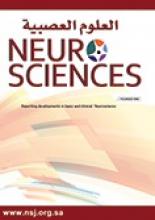Research ArticleOriginal Article
Open Access
Blockade of fast A-type and TEA-sensitive potassium channels provide an antiparkinsonian effect in a 6-OHDA animal model
Hashem Haghdoost-Yazdi, Hossein Piri, Reza Najafipour, Ayda Faraji, Negin Fraidouni, Tahereh Dargahi and Mahmud Alipour Heidari
Neurosciences Journal January 2017, 22 (1) 44-50; DOI: https://doi.org/10.17712/nsj.2017.1.20160266
Hashem Haghdoost-Yazdi
From the Student Research Committee (Faraji, Fraidouni, Dargahi), School of Medicine, and from the Cellular and Molecular Research Center (Haghdoost-Yazdi, Piri, Najafipour, Alipour Heidari), Qazvin University of Medical Sciences, Qazvin, Iran
PhDHossein Piri
From the Student Research Committee (Faraji, Fraidouni, Dargahi), School of Medicine, and from the Cellular and Molecular Research Center (Haghdoost-Yazdi, Piri, Najafipour, Alipour Heidari), Qazvin University of Medical Sciences, Qazvin, Iran
PhDReza Najafipour
From the Student Research Committee (Faraji, Fraidouni, Dargahi), School of Medicine, and from the Cellular and Molecular Research Center (Haghdoost-Yazdi, Piri, Najafipour, Alipour Heidari), Qazvin University of Medical Sciences, Qazvin, Iran
PhDAyda Faraji
From the Student Research Committee (Faraji, Fraidouni, Dargahi), School of Medicine, and from the Cellular and Molecular Research Center (Haghdoost-Yazdi, Piri, Najafipour, Alipour Heidari), Qazvin University of Medical Sciences, Qazvin, Iran
MDNegin Fraidouni
From the Student Research Committee (Faraji, Fraidouni, Dargahi), School of Medicine, and from the Cellular and Molecular Research Center (Haghdoost-Yazdi, Piri, Najafipour, Alipour Heidari), Qazvin University of Medical Sciences, Qazvin, Iran
MscTahereh Dargahi
From the Student Research Committee (Faraji, Fraidouni, Dargahi), School of Medicine, and from the Cellular and Molecular Research Center (Haghdoost-Yazdi, Piri, Najafipour, Alipour Heidari), Qazvin University of Medical Sciences, Qazvin, Iran
BScMahmud Alipour Heidari
From the Student Research Committee (Faraji, Fraidouni, Dargahi), School of Medicine, and from the Cellular and Molecular Research Center (Haghdoost-Yazdi, Piri, Najafipour, Alipour Heidari), Qazvin University of Medical Sciences, Qazvin, Iran
PhD
References
- ↵
- Dauer W,
- Przedborski S
- ↵
- Wang Y,
- Yang PL,
- Tang JF,
- Lin JF,
- Cai XH,
- Wang XT,
- et al.
- ↵
- Mathie A,
- Wooltorton JR,
- Watkins CS
- ↵
- Shieh CC,
- Coghlan M,
- Sullivan JP,
- Gopalakrishnan M
- ↵
- Wang G,
- Zeng J,
- Ren R,
- Chen S
- ↵
- Wang X,
- Xiao AY,
- Ichinose T,
- Yu SP
- ↵
- Yazdi HH,
- Janahmadi M,
- Behzadi G
- ↵
- Haghdoost-Yazdi H,
- Janahmadi M,
- Behzadi G
- ↵
- Glasauer S,
- Strupp M,
- Kalla R,
- Buttner U,
- Brandt T
- ↵
- Strupp M,
- Kalla R,
- Glasauer S,
- Wagner J,
- Hufner K,
- Jahn K,
- et al.
- ↵
- Haghdoost-Yazdi H,
- Faraji A,
- Fraidouni N,
- Movahedi M,
- Hadibeygi E,
- Vaezi F
- ↵
- Paxinos G,
- Watson C
- ↵
- Borlongan CV,
- Randall TS,
- Cahill DW,
- Sanberg PR
- ↵
- Moridi H,
- Karimi J,
- Sheikh N,
- Goodarzi MT,
- Saidijam M,
- Yadegarazari R,
- et al.
- ↵
- Yuan H,
- Sarre S,
- Ebinger G,
- Michotte Y
- ↵
- Abrous DN,
- Rodriguez JJ,
- Montaron MF,
- Aurousseau C,
- Le Moal M,
- Barneoud P
- ↵
- Borlongan CV,
- Sanberg PR
- ↵
- Wu ZZ,
- Li DP,
- Chen SR,
- Pan HL
- ↵
- Hayes KC
- ↵
- Leung G,
- Sun W,
- Brookes S,
- Smith D,
- Shi R
- ↵
- Franciosi S,
- Ryu JK,
- Choi HB,
- Radov L,
- Kim SU,
- McLarnon JG
- ↵
- McBride JM,
- Smith DT,
- Byrn SR,
- Borgens RB,
- Shi R
- ↵
- Matsumoto S,
- Yoshida S,
- Takahashi M,
- Saiki C,
- Takeda M
In this issue
Blockade of fast A-type and TEA-sensitive potassium channels provide an antiparkinsonian effect in a 6-OHDA animal model
Hashem Haghdoost-Yazdi, Hossein Piri, Reza Najafipour, Ayda Faraji, Negin Fraidouni, Tahereh Dargahi, Mahmud Alipour Heidari
Neurosciences Journal Jan 2017, 22 (1) 44-50; DOI: 10.17712/nsj.2017.1.20160266
Blockade of fast A-type and TEA-sensitive potassium channels provide an antiparkinsonian effect in a 6-OHDA animal model
Hashem Haghdoost-Yazdi, Hossein Piri, Reza Najafipour, Ayda Faraji, Negin Fraidouni, Tahereh Dargahi, Mahmud Alipour Heidari
Neurosciences Journal Jan 2017, 22 (1) 44-50; DOI: 10.17712/nsj.2017.1.20160266
Jump to section
Related Articles
- No related articles found.
Cited By...
- No citing articles found.





